Papers by Daniel Oppong-Sekyere
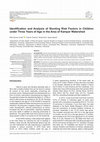
Uluslararası Disiplinlerarası ve Kültürlerarası Sanat, Dec 31, 2020
BACKGROUND: Growth and development that are not optimal are a form of chronic malnutrition, one o... more BACKGROUND: Growth and development that are not optimal are a form of chronic malnutrition, one of which is marked by height for age which is below the standard deviation (<−2 SD) and is called stunting. Stunting has a negative impact on children's motor development, reduces children's performance in school, increases the risk of excess nutrition, infectious diseases, and even death as well as reduces productivity in adulthood. AIM: The purpose of this study was to identify risk factors for stunting in people living in the Kampar watershed. METHODS: This research is a mixed-method with an explanatory sequential design which is a modification of. The research was carried out on people living in the Kampar river basin. The priority areas for specific stunting reduction interventions in this study are the Work Areas of the
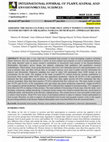
Women play a very vital role in household food security in most developing countries including Gh... more Women play a very vital role in household food security in most developing countries including Ghana. However, they are constrained by a variety of socio-cultural and economic as well as institutional barriers. This study therefore seeks to assess women's contribution to household food security in the Kasena-Nankana Municipality. Descriptive survey design was adopted, employing both qualitative and quantitative research methodologies. Observations, focus group discussions, interviews, key informant interviews and questionnaires were used as primary data, and other relevant data, as secondary sources, were used to gather relevant information for analysis and discussions. Purposive sampling was used to select 160 participants from 2,049 women in six communities for the study. The findings of the study revealed57.3% reacted positively towards contribution to household food security while 84.4% were into agricultural production. Almost all (83.8%) of the respondents indicated that t...
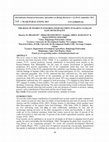
The r u r a l sector in many developing countries is increasingly characterized by the prevalence... more The r u r a l sector in many developing countries is increasingly characterized by the prevalence of poverty and food insecurity (FAO, 1990b: 2) In a qualitative and quantitative study of 160 women, 57.3% reacted positively towards contribution in household food security in the Kasena-Nankana East Municipality. On the issue of women involvement in agricultural production, 84.4 percent representing 135 of the respondents stated they were into food production. 83.8% of the 84.4% indicated that they undertake crop farming which was consistent with the findings of Akpabio (2005). Out of the 160 women participarts, 81.25% mentioned that they cultivated groundnut. Also 75.63% indicated that they cultivated rice. The study further revealed that 76.25% and 65.63% of the respondents are into beans and maize production respectively. Only 20% were into other crops not stated. 82% were engaged in animal production. Respondents indicated that 43% engaged in food processing, 37% engaged in farm l...
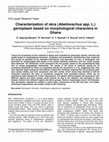
Journal of Plant breeding and Crop Science, 2011
Twenty five accessions of okra collected in Ghana were evaluated for phenotypic identity, diversi... more Twenty five accessions of okra collected in Ghana were evaluated for phenotypic identity, diversity and quality based on morphological characters. Qualitative and quantitative characteristics were measured and scored as specified by the standard international crop descriptor for okra. A dendrogram was generated for morphological data based on the simple matching coefficient, and four cluster groups were observed. The distribution of the accessions into the groups, based on the morphological traits had no unique geographical relationship. The results of the matrix of similarity among the 25 accessions performed by NTsys pc programme placed two accessions in a tie, suggesting that, they were identical. Eight accessions were placed at above 80% similarity, meaning that, the accession pairs were closely related, and three accessions were 50% similar, which means they matched at half the characters measured. Six pairs of accessions measured were somewhat diverse, which can be exploited b...
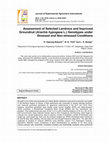
Journal of Experimental Agriculture International, 2019
Drought is one of the most essential and critical abiotic restraints to groundnut production and ... more Drought is one of the most essential and critical abiotic restraints to groundnut production and yields in the Northern Region of Ghana. A field experiment was conducted to assess selected landrace and improved groundnut genotypes for agronomic performance in the 2017 and 2018 minor seasons. Groundnut genotypes were treated under normal irrigation (W/W) and water-stressed (W/S) conditions. A Randomized Completely Block Design (RCBD) with four replications was adopted. Total experimental area was 23.4m x 2.4 m with a planting distance of 40 cm x 20 cm for both environments. Data collected include; days to 50% emergence and flowering, plant height at maturity (cm), growth appearance, days to maturity, number of pods/plot, number of seeds/plot, pod weight (g), seed weight (g), fresh and dry biomass weights (g), SPAD chlorophyll meter reading at 60 and 80 days after planting, harvest index (HI) and drought tolerance index (DTI). The data were subjected to analysis of variance (ANOVA) us...
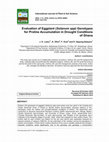
International Journal of Plant & Soil Science, 2019
Sixteen (16) genotypes of eggplant (Solanum spp) were grown over two years in the Coastal and Sud... more Sixteen (16) genotypes of eggplant (Solanum spp) were grown over two years in the Coastal and Sudan Savannah areas of Ghana to identify proline accumulation response patterns of the genotypes under dry season and drought-stressed conditions of Ghana. The experiment was conducted at Savanna Agricultural Research Institute (SARI) experimental farm, Manga, Bawku (Sudan Savannah Agro-ecology), and University of Ghana, Legon, Accra, experimental farm (Coastal Savannah Agro-ecology). At each agro-ecology, leaf samples of the genotypes were collected at the flowering stages of growth, dried, milled and assayed for their proline levels. The proline data for each location and season for the two year period were separately analyzed by general analysis of variance (ANOVA), for the estimation of the variation among the genotypes in proline accumulation. Proline which confers tolerance of the crop to variable seasonal and drought-stressed conditions varied significantly, due to the genotype and ...
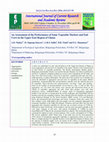
International Journal of Current Research and Academic Review, 2016
A study was undertaken in some selected districts in the Upper East Region of Ghana to assess agg... more A study was undertaken in some selected districts in the Upper East Region of Ghana to assess aggregators and end users of vegetable in the region. Districts were selected based on their history of vegetable production. The Bawku municipality, Binduri district, Bolgatanga municipality, Bawku west and the Kassina Nankana west district qualified for selection. A purposive sampling method was used to select respondents for the study, and these were interviewed using a check list of questions, comprising both open and closeended questions, to gather information. The main aim of the research was to identify and assess the potentials of aggregators and end users of vegetables in the region. Hotels/ guesthouses, restaurants/chop bars and institutions (schools) were the selected end users for vegetables. These end users were categorized into "very large", "large" and "medium", based on the number of guests/customers served food in a day. A total of fifty (50) aggregators, ten (10) from each district were selected and interviewed based on the volume of vegetables aggregated and sold, where their produce were sold, their prospective buyers, methods/facilities of storage, mode of transporting aggregated produce to the end user or storage point, the various challenges and relationships with the producer and end user regarding contracts. Data obtained from the checklist was analyzed using Statistical Package for the Social Scientists (SPSS version 17.0) and Microsoft Excel, and summarized into percentages and means. Tomatoes, Fresh okra, onion, Dry okra, cabbage, carrot, chilli pepper and sweet pepper were the commonly aggregated and consumed vegetables in the Upper East Region. Tomatoes and fresh Okra were the most aggregated and consumed vegetable by end users per an annual average of 27,090 kg, followed by onion (26,418 kg). Fresh tomatoes were the most consumed vegetable in the "very large" category of end users, with annual consumption of 1,560kg for guest house/Hotel and 8,736kg for the restaurants/chop bars category. The restaurants/chop bars consumed the highest in terms of fresh tomatoes with a yearly consumption of 8,736kg. The tricycle, popularly called "Motor king" in the study area was the most patronized (30%) means of transporting aggregated vegetables to aggregation centers or end users. There is a higher prospect for vegetable business in the Upper East Region of Ghana, with the capacity of adequate supply across all regions of the country, in particular and the export market, in general. Actors in the value chain have to grapple with the constraints of finance and storage facilities.
Journal of Scientific Research and Reports, 2016
A postharvest evaluation study of groundnuts ( Arachis hypogaea L.) was undertaken in a total of ... more A postharvest evaluation study of groundnuts ( Arachis hypogaea L.) was undertaken in a total of thirty (30) districts selected from the three Northern Regions of Ghana, namely, Upper West, Upper East and Northern, by employing the Participatory Rural Appraisal (P.R.A.) procedure. Ten (10) randomly selected, predominant groundnut growing districts were sampled in each case; interviews and focal group discussions were held which involved 600 individual key informants in all, 20 from
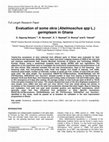
African Journal of Plant Science, 2012
Twenty-five accessions of okra collected from different parts of Ghana were evaluated for their h... more Twenty-five accessions of okra collected from different parts of Ghana were evaluated for their horticultural and agronomic attributes in the major and minor cropping seasons of 2008 at the crop and soil sciences experimental field, Kwame Nkrumah University of Science and Technology (KNUST) Kumasi, Ghana, using a randomized complete block design (RCBD) with four replications. The objectives of the experiment were to investigate the horticultural characteristics and performance of all the okra entries. Data collected included fruit and leaf characteristics; Days to first flowering, first flowering node, first fruit-producing node, fresh fruit weight, fruit length at maturity, fruit width, maximum plant height, number of internode, number of seeds per fruit, number of total fruits per plant, seed yield, 100 seed weight. The accessions KNUST/SL1/07Nkrumahene, DA/08/02Dikaba and GH 5787Asontem, GH6102Fetri and 'Asontem' showed number of days from sowing to first-flowering at between 44.00 and 48.00 days, first flowering and fruiting nodes at between 5.00 and 6.00th nodes, days to 50% emergence at 8 days after sowing, the average number to total fruits per plant at 60.00 to 145.00 fruits and green immature fruit colour. The results showed that most of the okra displayed symptoms of okra mosaic virus (OMV) and okra leaf curl virus (OLCV). Fruit size varied among the entries. A correlation of the characters with the total fruit production showed that plant height, days to flowering and nodulation, fruit yield and seed yield recorded positive and significant associations, which generally mean that they influenced fruit production or yield. Specific accessions; KNUST/SL1/07Nkrumahene, DA/08/02Dikaba and GH 5787Asontem, GH6102Fetri and 'Asontem', identified in this study, could be passed on to breeders for utilization in the okra improvement programmes in Ghana.
... ii DEDICATION This project is dedicated to my Uncle, Mr. Samuel Asare-Bawuah and the Oppong-S... more ... ii DEDICATION This project is dedicated to my Uncle, Mr. Samuel Asare-Bawuah and the Oppong-Sekyere family. Page 4. iii ... To Bill of the FORIG biotechnology laboratory, I say God bless you. To all my MSc. course mates; Mr. Stephen Yeboah, Mrs. Mercy Marilyn Akpalu, Mr. ...
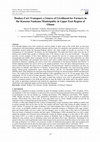
Journal of Biology Agriculture and Healthcare, 2013
Even through donkeys have been extensively used by people in many areas in the world, their use h... more Even through donkeys have been extensively used by people in many areas in the world, their use has been synonymous with backwardness, underdevelopment and low status. In a qualitative and quantitative study of 120 households located within the Kassena-Nankana district, this study sought to provide an overview of the consequences of 'development' for donkey use and management. The study also tried to show how the use of donkeys had enabled these people to withstand some of the threats to their lives and livelihoods. The paper provides several examples of how these different uses ensured the survival of women and men in hostile environments and enables them to integrate into the social and economic processes from which they are often excluded. Both primary and secondary data sources were used to gather relevant information for analysis and discussions. Purposive sampling was used to select four communities in the Kasena-Nankana East District. A hybrid sampling method was used to arrive at the sample population. Close and open ended questionnaire were used to collect data from the interviewees. In addition to the questionnaire, empirical verification was done via observation on attitudes and behaviors of farmers. Focused group discussions were held involving opinion leaders, farmer-group organizations, agric extension officers, and the 31st December Women's Movement (DWM) chiefs. Data obtained was analyzed using Statistical Package for Social Scientist (SPSS) and Microsoft Excel. The results of the study revealed that majority of the respondents were in 32-50 year group. Most of the respondents, 93 (58 %) had no formal education. Majority (75.5 %, 124), were married with 47% (74) having household sizes between six and ten. The study revealed that, donkeys were used in agricultural production, mainly to transport manure to the fields and the harvest from the fields to the homes and to the market centres; the youth in agriculture production had realized the importance of donkey transportation and farm traction, which had a very significant impact on food security development.

The International Journal of Plant, Animal and Environmental Sciences, 2013
A study was conducted in Sumbrungu, Bolgatanga Municipality of the Upper East Region of Ghana to ... more A study was conducted in Sumbrungu, Bolgatanga Municipality of the Upper East Region of Ghana to determine the level of cultivation and utilization of Bambara groundnut. A survey involving the use of both open-ended and close-ended questionnaires and also interviews were administered. A total of 30 Bambara groundnut farmers were selected. Houses were chosen depending on the concentration of Bambara groundnut farmers. Data was collected on the following; Sex distribution, number of acreages cultivated, household sizes, marketing and utilization, constraints in production and farmer management of the crop. Data collected were analyzed by the use of descriptive statistics; mainly percentages. It was observed that more people cultivated lower acreages of the crop; 40% of the farmers cultivated acreages of land between 1 and 2, 37% cultivated 3 and 4, 17% 5 and 6 and 6% between 7 acres and above. All (100%) farmers complained of attack of pests and diseases that destroyed the crop in the...
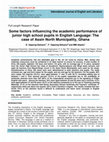
International Journal of English and Literature, 2013
Academic achievements, like any attainable goal in life, do not come by chance. Men, money and ma... more Academic achievements, like any attainable goal in life, do not come by chance. Men, money and materials (resources) must be combined in an ideal manner to ensure its success. A total number of thirty (30) pupils; eighteen (18) boys and twelve (12) girls, with an average age of 12 years, sampled from the Junior High School two class of Amoakrom, Nyame-bekyere and Ningo basic schools, and eight (8) teachers from Basofi-Ningo circuit in the Assin North Municipality were used for the study. Questionnaires of thirty (30) items each were administered to both teachers and pupils. The study reviewed sex, age and form (class) for the pupils, and sex and age for the teachers. For the pupils, 60% were males; the majority (43.4%), were aged between 11 and 14 with 36.7% recording sibling size of between 7 and 9. Over seventy percent (73.3%) of the pupils responded yes to the availability of textbooks whereas more than half (60%) of the respondents answered yes to the speaking of Pidgin English ...
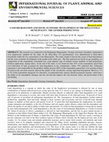
The research was conducted in the Bolgatanga Municipality. Nyariga and Zaare Amoabiisi communitie... more The research was conducted in the Bolgatanga Municipality. Nyariga and Zaare Amoabiisi communities were purposively sampled for the study. In all, thirty-three (33) questionnaires were administered to thirty-three households within the two communities in the Municipality. The study sought to find out the causes of land degradation and the socio-economic development of the people in the study area. The data analyzed was based on age grouping, sex composition of the respondents, household size, crops planted, type of animals reared, methods of land preparation, fertilizer application, among others. At the end of the study, it was found out that, 83% of the respondents agreed that over-cultivation of land accounted for land degradation in the communities, whiles 79% indicated that, settlement expansion is also responsible for the problem. Eighty percent (80%) of the respondents agreed that, over-grazing of their livestock in the area had seriously affected the quality of the soil there...
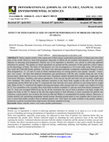
Maize supplies poultry with a major part of their energy requirement particularly in Ghana and so... more Maize supplies poultry with a major part of their energy requirement particularly in Ghana and some other parts of the world. However, most feed producers especially in Ghana do not examine feed particles size as a quality indicator in assessing feed preparation. Particle size of an ingredient is therefore very critical in achieving optimum utilization by animals. The manner in which ingredients are ground and the coarseness of that grind has a direct impact on the physiology of birds. The effect of feed particle size was investigated in a five-week study using 120 mixed-sex four week-old Cobb-500 broiler chickens. The birds were allocated randomly (completely randomized design) to three diets designated as T1 ,T2 and T3 each of which contained maize of varying particle sizes namely 'smooth,' 'coarse' and 'very coarse'. All diets had identical formulation and specifications with the only variable being the size of the ground maize. Birds had free access to feed and water. Parameters studied included feed intake, body weight gain, feed conversion efficiency, mortality, and carcass parameters. Feed cost per kg diet and feed cost per kg body weight gain were estimated. The results of the study indicated variations in the mean body weights at the end of the five-week experimental period. Birds fed on diet T1 consumed the least feed but were more efficient in converting feed to weight gain. Birds on diet T1 registered the highest dressing percentage while gizzard and liver weights were highest for birds on T3. Five mortalities were recorded, three from birds on dietary treatment T1 and one each from dietary treatments T2 and T3. Feed cost averaged GH¢0.30 per kg for all the treatments but cost of feed to produce a kg body weight was highest for birds on diet T3. Based on the fact that improvement in feed efficiency is more consistent for particle size reduction, a mean particle size of maize diet between 600 and 900µm is recommended for poultry farmers. Moreover, a routine particle size monitoring programme should include checking ground grain or one complete diet at least twice a year to assist feed millers produce feed of optimal particle size. Once these are made available to the poultry industry, production would be increased hence high income and better standard of living.

American Journal of Experimental Agriculture, 2014
An experiment was conducted in the major and minor cropping seasons of 2012 and 2013 under field ... more An experiment was conducted in the major and minor cropping seasons of 2012 and 2013 under field conditions at Bolgatanga Polytechnic, to study the effect of phosphorus fertilizer and Rhizobia inoculation on growth and yield of soybean using randomized complete block design and three replications. The treatments studied were: Soybean + phosphorus fertilizer + Rhizobia inoculation (+P/+I), Soybean + phosphorus fertilizer only (+P/-I), Soybean inoculated with Rhizobia (-P/+I) and the control-Soybean only (-P/-I). Results indicated that Phosphorus fertilizer application is required for shoot growth, pod and seed yield. Nodulation and root growth were significantly increased by Phosphorus + Rhizobia inoculation (+P/+I) but P fertilizer only did not enhance root growth. Dry matter accumulation was highest between onset of flowering and Podding. Grain yield was again highest for Rhizobia inoculation plus Phosphorus fertilizer (+P/+I) and Phosphorus fertilizer only (+P/-I) recording 7.61 t/ha and 7.30 t/ha respectively whiles Rhizobia inoculation only (-P/+I) and the control (-P/-I) produced the lowest grain yield (4.41 t/ha) and (3.80 t/ha) respectively.
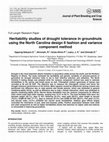
Journal of Plant Breeding and Crop Science
Drought is the most important abiotic limitation to groundnut yields across the world, and the No... more Drought is the most important abiotic limitation to groundnut yields across the world, and the Northern Regions of Ghana. The study estimated the heritability and genetic variability of selected parents of groundnut for drought tolerance traits to aid in their effective selection and utilization. The North Carolina II mating design was adopted while the variance component method was used to estimate heritabilities in the narrow and broad sense as well. Chlorophyll content (greenness of leaves) was recorded at 60 and 80 DAP. The objective was to measure the chlorophyll content and hence the drought tolerance performance of the entries. Mean squares caused by differences among crosses was partitioned into difference due to male parents and female parents, which was attributed to general combining ability (GCA), as well as difference due to male x female interaction, which was attributed to specific combining ability (SCA). Narrow Sense Heritability from the variance components for different traits varied under both water regimes, ranging from 12.2% to 95.7%. The most heritable traits were: dry biomass weight (95.7%), days to 50% flowering (91.0%), seed yield (90.0%), plant height at harvest (76.0%), SCMR 60 DAP (71.7%), days to maturity (67.0%) and SCMR 80 DAP (66.0%). Pod yield (12.3%) and harvest index (12.2%) exhibited low narrow sense heritabilities. Additive gene effects largely controlled the inheritance of pod, seed and biomass yields. Positive association between most yield and yield components as well as higher heritabilities shows that selection for higher yield and maturity is conceivable in improving groundnuts.
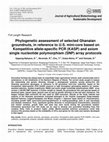
Journal of Agricultural Biotechnology and Sustainable Development
Groundnut farming has always been an essentially major agricultural venture, both commercially an... more Groundnut farming has always been an essentially major agricultural venture, both commercially and in subsistence, to the inhabitants of the Northern Regions of Ghana. The current study sought to assess the relationship and genetic diversity, through a phylogenetic analysis, among twenty-five (25) Ghanaian groundnut genotypes, in reference to US groundnut mini-core collection, based on the Kompetitive allele-specific PCR (KASP) protocol (a high throughput genotyping platform for markerassisted selection, studies [LightCycler 480II]) and axiom single nucleotide polymorphism (SNP) array version 2 (48,000 SNP features). It further sought to classify the groundnuts into sub-species based on botanical types, market types, general uses as well as genetic diversity to late leaf spot resistance. The Qiagen Dneasy DNA extraction Kit was used for DNA extraction. Results of the study indicate that majority of the Ghanaian groundnuts evaluated belonged to the Virginia (hypogaea) (large-seeded), Spanish/Valencia (vulgaris/fastigiata) and Mixed (Virginia x Valencia) types based on characteristics, including growth habit (erect/semi-erect/upright/bunch or trailing/spreading) seed or pod size/shape and disease resistance. Thus, significant genetic diversity in morphological characteristics, botanical and market varieties, growth habit and seed size were found among the groundnuts studied. Information generated from this study can be used to develop new groundnut breeding lines that combine these traits to produce higher yields. Marker-assisted selection procedures could help enhance this process based on the availability of QTLs and genes for the traits and markers developed in that regard.
Uploads
Papers by Daniel Oppong-Sekyere